February 8, 2008
Air Date: February 8, 2008
FULL SHOW
SEGMENTS
Coal's Carbon Capture in Question
/ Jeff YoungView the page for this story
The coal industry says it can trap its global warming gases and put them back in the ground where they came from - a process called carbon capture and storage. But the federal government just pulled the plug on the biggest carbon capture project, Futuregen. Living on Earth's Jeff Young reports on the big questions about carbon capture and coal's future. (06:00)
Wall Street Buys Into Climate Change
View the page for this story
Global warming is making Wall Street investment banks adopt new environmental standards for their clients. These standards called "The Carbon Principles," will force those seeking financing for coal plants to consider energy efficient and renewable options first. Host Bruce Gellerman talks with Pamela Flaherty, director of Citizenship at Citigroup. (06:10)
Listener Letters
View the page for this story
We dip into the LOE mailbag to hear kudos and criticisms from our listeners. (02:45)
Math on the Range
View the page for this story
Host Bruce Gellerman follows up on an interview about carbon-neutral buffalo ranching. He chews the numbers for grass vs. grain-fed livestock, and tells us how each contributes to our individual carbon footprints. (03:20)
Belching Cows
View the page for this story
Researchers at the Swedish University for Agricultural Sciences have just received a half million dollars to study belching cows. Believe it or not, methane exits each end of a cow as it consumes grass and grain. With millions of cows on the job, methane, a powerful greenhouse gas, adds up. Professor Jan Bertilsson joins host Bruce Gellerman to talk about how changing a cow's diet might fight climate change. (03:40)
Naked in the Woods
View the page for this story
Author Jim Motavalli takes us back 100 years to talk about the life and times of a man intent on proving he could survive naked in nature. Motavalli chats with host Bruce Gellerman about his new book "Naked in the Woods: Joseph Knowles and the Legacy of Frontier Fakery." (07:35)
40 Days, Carbon-free
View the page for this story
Two of the Church of England's most senior Bishops are calling for its members to give up carbon...for Lent. Host Bruce Gellerman speaks with Paul Cook. He's with Tearfund, the Christian relief and development organization that's leading the 40-day carbon fast. (04:10)
The Chemistry of Love
View the page for this story
Research shows that when people talk about relationship chemistry they really are talking about chemicals. Steve Curwood talks with Helen Fisher of Rutgers University to find the science behind love at first sight and happily ever after. (11:00)
This week's EarthEar selection
listen /
download
The Canada Glacier in Antarctica grinds its way over the earth.
Show Credits and Funders
Show Transcript
HOST: Bruce Gellerman
GUESTS: Jan Bertilsson, Pamela Flaherty, Jim Motavalli, David Tisch
REPORTERS: Jeff Young
[THEME]
GELLERMAN: From Public Radio International—this is Living on Earth.
[THEME]
GELLERMAN: I’m Bruce Gellerman. It’s lights out for the power plant of the future—federal funds go up in smoke as the Government pulls the plug on an ambitious project designed to capture greenhouse gases from burning coal.
ROMM: People’s conception of how much it can deliver is probably wildly overrated and one just has to put a big question mark on it.
GELLERMAN: Also banks hedge their bets on the risky business of building coal plants. And Extra Extra!! – read all about it! – bare in the woods – going nude - to sell papers.
MOTAVALLI: In many ways this was the first reality show – they didn’t have T.V. but they did have daily newspapers and they were able to chronicle his adventures every day with messages he wrote in birch bark.
GELLERMAN: The naked truth about frontier fakery—and more this week on Living on Earth. Stick around!
ANNOUNCER: Support for Living on Earth comes from the National Science Foundation and Stonyfield Farm.
[MUSIC: Boards Of Canada “Zoetrope” from “In A Beautiful Place Out In The Country” (Warp Records 2000)]
[THEME]
Coal's Carbon Capture in Question
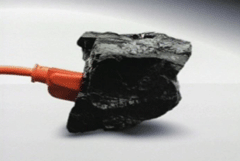
(Photo: America's Power)
GELLERMAN: From the Jennifer and Ted Stanley Studios in Somerville, Massachusetts—this is Living on Earth. I’m Bruce Gellerman, in for Steve Curwood.
Half of the country’s electricity comes from burning coal. But along with the energy, coal pumps a lot of greenhouse gases into the atmosphere, contributing to global warming. The coal industry says it can meet the challenge of climate change with technology called carbon capture and storage—basically, grabbing the CO2 and putting it back where it came from: in the ground.
Maybe you caught this TV ad by the coal industry:
VOICEOVER: We’re committed to a future in which our most abundant fuel—coal—generates our electricity with even lower emissions, including the capture and storage of CO2.
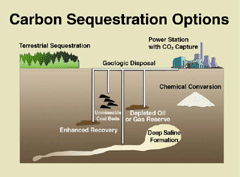
Carbon storage, or sequestration, essentially puts the CO2 back in the ground where it came from, so it does not become a greenhouse gas in the atmosphere. It can work, but the massive volume of CO2 in question presents great challenges. (Courtesy of the Department of Energy)
And as Living on Earth’s Jeff Young reports, that raises questions about the future of coal.
YOUNG: You know that a once obscure energy technology has become pretty important when it becomes an applause line in the president’s State of the Union address.
BUSH: Let us fund new technologies that can generate coal power while capturing carbon emissions. (Applause)
YOUNG: That applause came from both sides of the partisan aisle. Nearly everyone in Washington with a plan for climate change is banking on carbon capture and storage, also known as sequestration, to play a big role. Energy secretary Sam Bodman says it’s crucial to the future of coal.
BODMAN: The heart and soul of using coal, which we are great believers in, is going to be using carbon capture and sequestration, and that’s exactly what we are trying to accomplish.

The zero-emissions coal power plant envisioned by the FutureGen Alliance looked good on paper, but ballooning costs caused the government to scrap these plans. (Photo: FutureGen Alliance)
HOVORKA: Sequestration is absolutely doable. If I got so say one thing to people out there it would be that if you want power that reduces your guilt of releasing CO2 into the atmosphere, you can have it. The question is, do people want it? Because it's not free.
YOUNG: And the price is taking a toll on the biggest carbon capture project yet proposed. For the past four years the centerpiece of that research by both the government and the private sector has been FutureGen.
MUDD: FutureGen is further ahead than any other such plant in the world.
YOUNG: That’s Mike Mudd with the FutureGen Alliance. Two dozen of the world’s biggest producers and users of coal joined with the Department of Energy to plan the first zero emissions coal power plant. After three years of study, the alliance met in December to announce where the plant would be built.
MUDD: So now the moment we’ve been waiting for: the alliance intends to select Mattoon, Illinois, to host the FutureGen project. (smattering of applause)

The coal power industry says it can cut carbon dioxide emissions from coal. But the government just pulled the plug on the industry's leading carbon capture project. (Photo: America's Power)
BODMAN: I felt it didn’t make sense to go forward. It was at that point in time that I blew the whistle on the project.
YOUNG: Bodman insists he’s not scrapping the project, but rather restructuring it to clarify its purpose and get industry to pay a greater share of the cost. Those private sector partners were disappointed. FutureGen alliance member Paul Thompson, with the energy utility company E-ON, says it will be much harder for his industry to learn how to apply carbon capture on a commercial
scale.
THOMPSON: If you don’t have a FutureGen I think you’re just gonna delay the time frame for getting the answers that we need.
YOUNG: It’s not yet clear if the companies involved will continue with the restructured project. On capitol hill, anxious coal-state senators, like Wyoming’s John Barrasso and John Tester of Montana, let Bodman know they were not happy.
BARRASSO: And with this change with FutureGen I think that confidence is eroding.
TESTER: I echo Senator Barrasso’s comments. We have to have the technology.
YOUNG: The most optimistic target for a FutureGen startup is now 2015—four years later than originally planned. Energy experts say it raises real doubts about the promise of carbon capture
as a climate solution.
ROMM: I don’t think it’s a good sign that the government and industry could not get their act together, figure out what this project was supposed to be and then do it, given how important it is for the future of their country and the planet.
YOUNG: Joseph Romm served in the energy department during the Clinton administration. Now he’s a fellow at the Washington think tank, Center for American Progress. Romm says the sheer volume of CO2 from coal presents more hurdles. Simply moving it around would require miles of new pipelines. A large release could prove fatal and there are risks to underground water supplies. The Environmental Protection Agency says it will take another three years just to write regulations on that. Romm thinks it all means carbon capture will be much more difficult than many of its proponents would like.
ROMM: People’s conception of how much it can deliver is probably wildly overrated. So I’m hopeful that carbon capture and storage could be part of the solution, but I think people need to understand it is certainly no silver bullet and one just has to put a big question mark on it.
YOUNG: And with FutureGen pushed even further into the future, the promise of more climate-friendly coal power is up in the air. For Living on Earth, I’m Jeff Young in Washington.
Related links:
- DOE's Carbon Capture program
- The FutureGen Alliance
- MIT study on carbon capture and the future of coal
- Joseph Romm on FutureGen in his blog "Climate Progress"
Wall Street Buys Into Climate Change

Pamela Flaherty, Director of Citizenship at Citigroup (Photo: Citigroup)
GELLERMAN: Well it’s cold hard cash that fuels the construction of coal power plants—and now Wall Street is getting worried about the real cost and risk of coal. So three of the nation’s financial powerhouses have developed a new set of principles to help guide their investments.
Pamela Flaherty is Director of Citizenship at Citigroup, it’s one of the megabanks that wrote the Carbon Principles. Ms. Flaherty, welcome to Living on Earth.
FLAHERTY: Thank you very much, I'm delighted to be here.
GELLERMAN: What are the carbon principles?
FLAHERTY: The carbon principles are a set of guidelines that enable financial institutions and their U.S. utility clients to evaluate the risks involved in financing various kinds of conventional power plants.
GELLERMAN: Conventional being coal.
FLAHERTY: Coal and other kinds of fossil fuels.
GELLERMAN: So what’s the first carbon principle?
FLAHERTY: Well the principles embody a portfolio approach. So we are talking about the need to first look to energy efficiency to do better with what we have. Secondly, to look at renewables. And thirdly, then, to look at conventional power, which would include coal, oil and gas. So all three of those have a role to play in delivering energy to consumers at reasonable prices in the United States. And we are looking to our clients to articulate that they have looked at all of these. They do in fact have a need for financing for a conventional power plant—that is a heavy greenhouse gas emissions plant. There is an enhanced due diligence process that is part two of these principles.
GELLERMAN: So you’re trying to recalibrate your risk for investing in the companies that produce carbon-based power?
FLAHERTY: Correct.
GELLERMAN: Why now?
FLAHERTY: Because I think this is a point in time when both our clients and financial institutions are increasingly understanding that climate change is a critical issue and that this country and this economy are going to have to figure out ways to reduce the greenhouse gas intensity and that there is a high probably that some kind of legislation will pass in the future. So all of us are trying to understand how we asses that risk, how we price that risk, and how we work on it together.

Pamela Flaherty, Director of Citizenship at Citigroup (Photo: Citigroup)
FLAHERTY: Correct. And they would assign a price to carbon and that price needs to be figured into the risk. And one of the beauties of having three financial institutions and having several utilities and two environmental NGOs involved in this process is there’s a common understanding of what the principles are and what the enhanced due diligence is. So it isn’t a surprise to anyone and we hope that it will become an industry standard, if you will.
GELLERMAN: I know that Environmental Defense was part of your discussions.
FLAHERTY: Environmental Defense and NRDC both.
GELLERMAN: The NRDC. The National Resources Defense Council.
FLAHERTY: That’s correct.
GELLERMAN: There are environmental groups who say you’re not going far enough, that if you really wanted to do something about greenhouse gases you’d simply say ‘we’re going to set either strict limits or have very strong reduction targets.’
FLAHERTY: We understand that coal supplies over 50 percent of the electricity in the United States, and it’s expected by everyone who’s involved in this process that it will continue to play a role, what we’re trying to do in this process is to understand what those risks are, what that role is, and factor that into both the risk and the price.
GELLERMAN: Now because one of your principles, one of the top principles, is an emphasis on renewables—does that mean that Citigroup would be more inclined to lend to a renewable energy company?
FLAHERTY: I think all three financial institutions and certainly Citi is very interested in financing renewable opportunities. In fact, last May, we announced a 50 billion dollar ten-year commitment to invest and lend in renewables and clean technology. So we’re very interested in that. And in fact, I think many of our clients are as well.
GELLERMAN: What implications, if any, does this have for nuclear power and Citigroup’s financing of nuclear power plants?
FLAHERTY: I think all of the financial institutions and the utilities involved believe that nuclear power is an important option to consider in addressing climate change but we also all recognize that nuclear plants carry all sorts of other risks that financial institutions must consider.
GELLERMAN: Have other financial institutions beside Citigroup—JP Morgan, Chase, and Morgan Stanley—come on and said ‘oh, we want to sign on to the carbon principles, too’?
FLAHERTY: There are all sorts of active conversations going on right now with other financial institutions and we would be delighted to have them also adopt these carbon principles.
GELLERMAN: What’s been the reception from your clients—the people who come to you to borrow money to build the plants?
FLAHERTY: I think it’s mostly been very positive and in fact that’s why we went to such great lengths and spent ten months to make sure we consulted with our clients. So we understood what their concerns were. We explained what we were trying to do and got their involvement in it. And as I said from the beginning of this conversation, one of the most important things about both the principles and the enhanced due diligence is that it was created by such an interesting group that involved our clients, the financial institutions, and the environmental NGOs. And that, I think, is a real first, and a very important sign that we need to move beyond arguing with each other and come up with creative, positive solutions and I think that’s what this is.
GELLERMAN: Ms. Flaherty, thank you very much.
FLAHERTY: Thank you very much.
GELLERMAN: Pamela Flaherty is director of citizenship at Citigroup.
Related links:
- Citigroup's press release on The Carbon Principles
- J.P. Morgan Chase's Environment page
- Morgan Stanley's Environment page
- NRDC's press release on The Carbon Principles
- Envrionmental Defense
[MUSIC: Omar Sosa “D’Son” from Afreecanos (OTA Records. 2008)]
GELLERMAN: Just ahead—the bare truth about going naked in the woods. Stay tuned to Living on Earth.
Listener Letters
GELLERMAN: It’s Living on Earth, I’m Bruce Gellerman.
[LISTENER LETTERS THEME]
GELLERMAN: You hear from us every week—today we hear from you.
Francis Rengers hears us on KCFR in Denver, Colorado. He has kind words for our series Home Ground: Language for an American Landscape, where writers who contributed to the book by that title describe features of our physical geography.
Mr. Rengers writes, “there’s an entire branch of science dedicated to describing landscape form and process. It’s called geomorphology.”
James Biddle listens to our podcast from his home in Annapolis, Maryland. He writes, “You're show is amazing! I’m 12 years old and I am very concerned about climate change and excited about its solutions. I think Living on Earth is the best eco show ever. Keep it up!”
Well, from kudos to coconuts and our story about a South African warning system for sharks. In my introduction, I cited the International Shark Attack File as claiming falling coconuts kill 150 people each year—two and a half times more fatalities than from sharks.
Well I got it on the noggin from a number of listeners, including Amy from Oakland, California who tunes in to KQED. Amy has it from a higher authority, Cecil Adams in his column “The Straight Dope,” that the stat is just an urban—or should we say tropical island—myth. “But,” she writes, “you did at least spark my curiosity.”
And this correction in our story about recycling water – we mistakenly said that Las Vegas discharges 200,000 gallons of waste water into Lake Mead every day – it’s more like 200 MILLION gallons.
[STAR TREK SOUND EFFFECTS]
GELLERMAN: My interview with Sydney Perkowitz, author of “Hollywood Science,” drew a lot of fire from Star Trek fans
[STAR TREK SOUND OF A “HIT”]
GELLERMAN: Ah, ya got me. I mistakenly compared mobile phones to transponders. “Transponders on Star Trek?” asks WUNC listener David Jennings incredulously. “NO, they were called communicators and were the inspiration for cell phones.”
[SFX—“Scotty, beam me up.”]
GELLERMAN: Well, wherever in the cosmos you’re receiving us, we living on earthlings pay attention to your feedback, so use the communication device of your choice. Our email address is letters@loe.org. That’s letters at L-O-E dot O-R-G. Our listener line is 800 218 99 88.
Math on the Range
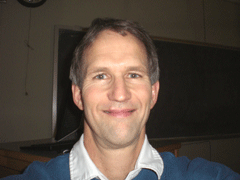
Dave Tisch (Photo: Dave Tisch)
GELLERMAN: And also this clarification: I recently interviewed Ken Klemm, who raises 600 head of buffalo on his Kansas ranch and says unlike beef cows, buffalo, or bison, are carbon neutral because of what they eat—grass—versus grain for cows. But when you have to include transporting the meat to market, and consider the total CO2 foot print, ah—then the buffalo guy Klemm says the calculations gets complicated.
KLEMM: Well, I guess we'd have to sit down and do the math, wouldn't we?
GELLERMAN: Well in the land where seldom is heard a discouraging word, we heard from one listener who actually did the math. David Tisch is a professor at the College of Agriculture and Technology at the State University of New York at Cobleskill – and he had something of a beef with our story.
TISCH: Well, not exactly a beef. I guess I do agree with Ken Klemm in some aspects but I think that it’s a little bit more complicated than just substituting buffalo for beef. The real question is grass-fed versus grain-fed. And buffalo can be grain-fed and many are and beef animals can be grass-fed and many are. And in fact, prior to World War Two, most beef animals in this country were produced on grass. But, what’s happened now, a lot’s changed, and it’s cheaper to produce beef on grain than it is to produce them on grass.
GELLERMAN: And what’s the relationship between grain and CO2 emissions?
TISCH: Well, grasses are perennials. And that means that they grow back year after year and there’s not a lot of fuel used to produce the grasses. Grains, however—when you feed animals grain you really mean you’re feeding them corn and corn is an annual. And that means every year you have to plow, plant, fertilize, spray, harvest it, dry it and grind it. There’s a lot of inputs when you’re producing grain for grain-fed beef. But, the reality is that it’s cheaper now to produce grain-fed animals than grass-fed.
GELLERMAN: So, let’s do a hypothetical. Say you’ve got in stall number one, animal ‘A.’ This animal was grain-fed and it was eaten in let’s say in Fort Collins, Colorado, where it was raised. What’s the C02 footprint of that animal?

Dave Tisch (Photo: Dave Tisch)
GELLERMAN: So more C02 is produced than the steak itself?
TISCH: That’s right. More C02 is produced during the production when it’s grain-fed than it would be actually for transportation if you didn’t use grain.
GELLERMAN: Okay, then. Behind stall number two we’ve got animal ‘B.’ And this one was not grain-fed but it was shipped from say Fort Collins, Colorado to me, here in Boston. What’s the CO2 footprint of that one?
TISCH: That one’s CO2 is about .3 pounds of carbon dioxide.
GELLERMAN: Whoa! Big difference.
TISCH: There really is a big difference.
GELLERMAN: So it’s not the transportation; it’s the grain.
TISCH: That’s right. All the inputs of fuel to produce the grain result in more carbon dioxide emission than even transportation 2,000 miles.
GELLERMAN: So Ken Klemm’s claim and the Buffalo Guys is correct then?
TISCH: It really is correct. But if everybody decided to switch to a grass-fed beef product without changing their consumption, there would be another impact on the environment, because it takes more land to produce grass-fed beef than it does to produce grain-fed. So I think the bottom line is that everybody should be eating grass fed—less impact on the environment in terms of CO2 emissions, but we should be eating less beef because less beef means that there won’t be additional land having to be devoted to beef production.
GELLERMAN: Well, a lot to chew on.
TISCH: (laughs) It really is. It’s quite a complicated deal.
GELLERMAN: David Tisch is a professor at the College of Agriculture and Technology at the State University of New York at Cobleskill. Well professor, I really enjoyed our conversation. Thanks a lot!
TISCH: You’re welcome.
[SOUND OF COWS]
Related link:
Dave Tisch's website
Belching Cows
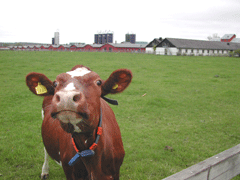
Swedish cows like this already wear collars that electronically identify each animal when she is milked or fed. Bertilsson will equip them with much larger collars to measure methane. (Photo: Jan Bertilsson)
GELLERMAN: Carbon dioxide isn’t the only greenhouse gas that comes from cows—there’s methane as well, and it’s 20 times more damaging to the atmosphere than CO2.
That’s why Swedish scientist Jan Bertilsson is trying to measure just how much methane comes from cows. And it takes some doing. Dr. Bertilsson joins us from his lab at the Swedish University for Agricultural Sciences in Uppsala. Welcome to the show.
BERTILSSON: Hello.
GELLERMAN: How do you measure the methane from a cow?
BERTILSSON: You can do it by putting them into an air-tight room and collect everything that comes out from them but that’s laborious and costly and so on. But there is a method where we use tracer gas. We let out a specified amount of sulfuric fluoride and we can calculate how much methane is produced. But we are collecting the gas all the time. Near the mouth of the animal we have a special collar around the head of the cow where we collect the gas.

Jan Bertilsson (Courtesy of Jan Bertilsson)
BERTILSSON: Nose—yes. Because 95 percent of the gas comes from the nose. Only five percent comes from the back of the cow.
GELLERMAN: Yeah, I would have thought, actually, that most of it would have come from the other route.
BERTILSSON: No. That’s what people think in general.
GELLERMAN: So what produces the methane? I mean, all cows have to eat.
BERTILSSON: Yeah. It’s when they digest their feed in the stomach there’s no oxygen and in that procedure there is bound to be formed the methane because there are certain microbes in the ruman of the cow.
GELLERMAN: Well, are there things that the cows eat that produces more or less methane?
BERTILSSON: In general we think that it’s grass and grass products would probably be a bit more than grain or, like, corn or that sort of thing. In fact, one of the things we are looking into is feeding more grass products will give more methane. And especially, we have in this country a large interest for organic production and in that sort of production more grass is fed to the cows and one suspicion is that that might give more methane and that’s something we want to check.

Swedish cows like this already wear collars that electronically identify each animal when she is milked or fed. Bertilsson will equip them with much larger collars to measure methane. (Photo: Jan Bertilsson)
BERTILSSON: They do it all the time because they spend most of their days eating and chewing so I would say that at least two thirds of the day they will spend on chewing and ruminating and all that time they will also be gasses let out from their stomachs. Because if they don’t—sometimes if it’s blocked in some way or another then the animal is in danger, she will, in the end she will die if she can’t get rid of all these gases.
GELLERMAN: Who’s interested in your research?
BERTILSSON: There is a demand from the trade. They want to label their products that they have a good effect on the environment and also the environment protection agency in this country. They want to report emissions of greenhouse gases and they want accurate figures on this from animals and from agriculture.
GELLERMAN: Well I want to thank you very much Dr. Bertilsson, it's been a real pleasure.
BERTILSSON: Nice talking to you.
GELLERMAN: Jan Bertilsson studies burping cows at the Swedish University for Agricultural Sciences in Uppsala, Sweden.
[MUSIC: Weird Al Yankovick “Who Let The Cows Out” From You Tube Video]
Related link:
Swedish University for Agricultural Sciences
Naked in the Woods

"Naked in the Woods: Joseph Knowles and the Legacy of Frontier Fakery" (Photo: Da Capo Press)
GELLERMAN: One of the more bizarre chapters in American history began on August fourth, 1913, when Joseph Knowles, stripped to the buff, and, unarmed and alone, trekked off into the woods of Maine’s Dead River Country.
Two months later he showed up in Canada, dressed in bark sandals, deerhide, and a bearskin, happy and well-fed, demonstrating that modern man could thrive, and survive, in the wilderness.
Knowles’ exploits made him a national celebrity. The story of Joseph Knowles and this strange period in the American experience is chronicled by Jim Motavalli in his new book, “Naked in the Woods: Joseph Knowles and the legacy of Frontier Fakery.”
Jim Motavalli joins me from Connecticut where he lives. Mr. Motavalli – thank you very much!
MOTAVALLI: Great to be on.
GELLERMAN: This guy, Joseph Knowles, was quite a character.
MOTAVALLI: He was indeed a character and he definitely comes across as one of the more colorful figures from that era. You know, history can tend to be sort of gray but he was definitely in Technicolor.
GELLERMAN: Well, let’s go to the story. He is commissioned by the newspaper the Boston Post to go off and survive in the wilds of Maine.
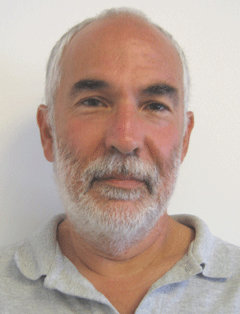
Jim Motavalli (Courtesy of Jim Motavalli)
GELLERMAN: Well, they take Knowles up on his offer and he treks off into the north woods of Maine and survives!
MOTAVALLI: He does indeed survive. He kills a bear. That was probably the highlight of his adventures in the woods. He killed a bear and some deer. He made things out of deer hide and he wore the bearskin. And he made simple tools and he emerged really smelling like a rose and it’s not surprising that something like 100,000 people were there in the streets of Boston when he arrived by train and it was really a media frenzy for something like a week.
GELLERMAN: He taps into this zeitgeist, this longing for an American nostalgic period when primitive man survived in the wild.
MOTAVALLI: Yes, there was definitely a connection with frontier figures like Daniel Boon and Davy Crockett and Kit Carson. And certainly the sight of him in a bearskin with his primitive tools that he made in the woods—it was extremely iconic. And in many ways this was the first reality show—they didn’t have television but they did have daily newspapers and they were able to chronicle his adventures everyday with messages he wrote in birch bark that he left to be picked up. And he was even able to illustrate them with charcoal sketches that he did. So this really got the reading public very keyed up.
GELLERMAN: Yeah, he basically reports that he’s living in the lap of primitive luxury.
MOTAVALLI: Yes, he was very boastful of his ability not only to survive in the woods but to thrive. And he would talk about how he was living better than any king and he had three-course meals. This was all very ironic when he was charged with being a fraud. The rival newspaper—the Boston American—which was a Hearst publication, said that he’d actually been faking it and had been living in comfort in a cabin and was being supplied with food and even female company. But the Hearst papers were very aware that Knowles had doubled the circulation of the Post. So after that fury died down they then hired him again. And he did two more expeditions under the Hearst banner. So if they thought he was a fraud it obviously didn’t bother them that much.

"Naked in the Woods: Joseph Knowles and the Legacy of Frontier Fakery" (Photo: Da Capo Press)
MOTAVALLI: Right. You have to see this in context, ‘cause Teddy Roosevelt had recently been the president and he sort of spear headed this idea that the American boy had gotten very soft. And that was the reason for the Boy Scouts and Knowles very much supported the Boy Scouts and talked a lot about this idea of the American boy becoming a sissy and molly-coddled and all that kind of stuff. And the book that he wrote, which is called “Alone in the Wilderness” very much addresses these issues and says that the wilderness is a cure for the modern ailment of too much civilization.
GELLERMAN: So, you’re suggesting that there’s this modern American anxiety and this attempt to reclaim a lost American identity.
MOTAVALLI: Yes, I think that was very much why Knowles was such a success. You would think in looking at it that in 1913, that a lot of people would have basic wilderness skills. For instance, they’d be able to rub two sticks together and make fire. But Knowles actually went on the Vaudeville circuit and the rubbing sticks together and making fire on stage was the highlight of the whole thing. And evidently people had lost that skill and they were very impressed by it and all the other things that he said he could do, such as eating wild plants and setting traps for animals and fishing with sticks. They were enthralled.
GELLERMAN: A lot of people that are spawned by Joseph Knowles wind up kind of doing bizarre things. Sort of outdoing Knowles.
MOTAVALLI: Right. He had many imitators—people who went naked into the woods to try to prove that they could do it, too. And in almost every instance it fell through for one reason or another. Often, really dramatically. In some cases they were attacked by bugs, in some cases it snowed. In some cases they were arrested. But, you know, success spawns flattery and there were definitely a whole lot of Knowles imitators out there—for the next something like 20 years after that.
GELLERMAN: The one that really caught my eye is this guy from Brooklyn—Eden Abez—have I pronounced it correctly?
MOTAVALLI: Yes. Eden Abez was what was called a ‘nature boy,’ and these were Hollywood-based—they actually camped right under the Hollywood sign—and essentially they celebrated eating vegetarian, going naked wherever possible, hiking in the woods. And they had a fair amount of success in Los Angeles and Eden Abez wrote the song “Nature Boy,” which was recorded by Nat King Cole. And they were fairly well known. Of course, they were seen as eccentric and they started some of the first vegetarian restaurants in Los Angeles. Whether there’s a direct connection between Knowles and these people is probably doubtful. I don’t think he would have really enjoyed their message all that much but his message was pretty simple—you can get back to your basic nature if you go into the woods. You can find out what you’re made of. You can recapture the essential humanity of yourself. And he espoused this to the end of his days.
GELLERMAN: Well, Jim Motavalli. Thank you very much.
MOTAVALLI: Thank you.
GELLERMAN: Jim Motavalli is editor of “E/The Environmental Magazine” and author of the new book “Naked in the Woods: Joseph Knowles and the Legacy of Frontier Fakery.”
Related link:
"Naked in the Woods: Joseph Knowles and the Legacy of Frontier Fakery" by Jim Motavalli
[MUSIC: Nat King Cole “Nature Boy” from Greatest Hits (Capitol Records 1994)]
GELLERMAN: Coming up—What would Jesus do about global warming? Stay tuned to Living on Earth.
ANNOUNCER: Support for the environmental health desk at Living on Earth comes from the Cedar Tree Foundation. Support also comes from the Richard and Rhoda Goldman Fund for coverage of population and the environment. This is Living on Earth on PRI: Public Radio International.
[MUSIC: Grey Boy All Stars ” What Happened To TV? “ from What Happened To TV? (2007 SCI Fidelity Records)]
40 Days, Carbon-free
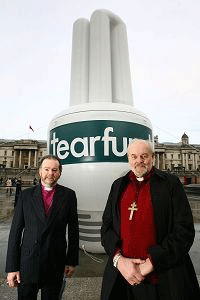
Richard Chartres, the Bishop of London (right) joins James Jones, the Bishop of Liverpool, to launch the Carbon Fast. (Photo: Press Association/Tearfund)
GELLERMAN: It’s Living on Earth, I’m Bruce Gellerman. Many Christians around the world are observing Lent, representing the 40 days Jesus spent in the desert, where according to the New Testament, he endured temptation by Satan through fasting and prayer.
Well today, Christians mark the liturgical season, giving alms, and traditionally make symbolic sacrifices—perhaps giving up chocolate, candy or alcohol. But in an era of global warming, two of the Church of England’s most senior Bishops want members of the faith to follow in the footsteps of Jesus—and cut their carbon footprint.
Joining us from Teddington, South West London is Paul Cook head of policy with Tearfund, a Christian relief and development organization, which is leading the Lent Carbon Fast.
Hello, Mr. Cook. You have some high authorities weighing in on your effort: the Bishop of London, the Bishop of Liverpool.
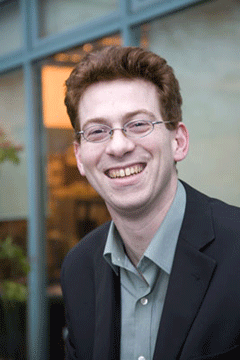
Paul Cook (Photo: Tearfund)
GELLERMAN: How has the flock of the faithful reacted to this?
COOK: We’ve had a very positive response. We’ve already run out of the 50,000 carbon fast booklets that we produced on renewable materials of course. And we know that millions more people have been made aware of the carbon fast through the media profiles received. I should say the reason Tearfund’s got involved in this is we are a Christian relief and development agency, and so we’re working with some of the poorest communities around the world in Africa, Asia, and Latin America. And over the last few years we’ve seen these communities being impacted by the change in climate. So climate change really hits the poorest hardest. But of course, the causes of climate change are back in the U.K. and the U.S. and other developed countries where we emit much more greenhouse gas than we should. And so, you know, this Lent the carbon fast is a great way to kind of challenge us to do something about that, to rectify some of that injustice.
GELLERMAN: So, what are some of the other 40 ways?
COOK: We’ve got a number of things lined up. As I say, there’s some basic stuff like checking your home for drafts, taking a little feather and running it along the side of your window—seeing are there are drafts there. Other things are things like insulating your roof, to make sure again that you’re using less heating. We’re getting people to replace their old light bulbs with new energy efficient light bulbs. And we estimate that if you took these actions, then you could reduce the greenhouse gas emissions of your household by up to 50 percent.

Richard Chartres, the Bishop of London (right) joins James Jones, the Bishop of Liverpool, to launch the Carbon Fast. (Photo: Press Association/Tearfund)
COOK: Myself and my family, we’ve been doing the carbon fast as well, so yesterday we unscrewed our light bulb, which is the first act of the carbon fast and this morning we have been checking our house to see actually are there any drafts, is there excluders that we do need to fit. So we’re looking at it in our own house, in our own lifestyle, and one of the things we’ve also been looking at is how many flights we take and where we go on holiday and whether we could be reducing that. We feel it’s really important for us, actually, if we’re calling on others to do this we need to be doing it ourselves as well. And it can be fun as well and help you to get a bit fitter, as you cycle a lot more and drive your car less.
GELLERMAN: This is a presumptuous question, but what would Jesus give up do you think?
COOK: Wow, that’s a really challenging question. I think Jesus would want to be at the forefront of seeing how he could live a much simpler and basic lifestyle. I think people sometimes wonder why are Christians getting involved in issues like the environment but as I say we look, as a Christian development agency, we see the impact that climate change is having on some of the poorest, most vulnerable communities in the world, and if there’s one clear message that comes through the Bible it’s that God loves the poor, he loves the vulnerable and the marginalized. And so I think Jesus would want to be at the forefront of making sure his actions were having a positive action on the poor, not hurting them.
GELLERMAN: I don’t mean this as a facetious question, but the beginning of Lent is Ash Wednesday, right?
COOK: Yes.
GELLERMAN: You have to put ash on your forehead. That’s carbon!
COOK: (laughs) Yes, that’s a tradition I think which goes back long before the science that identified the carbon as being a major cause of human-induced climate change.
GELLERMAN: Are bishops telling priests to preach the gospel of conservation in their churches?
COOK: I think this is a message that the church is putting out in many different ways, and certainly the Bishop of London, the Bishop of Liverpool we’re doing this carbon fast with, it’s a very strong part of what they see as their mission and their calling, and it’s certainly something they’re promoting within their churches as well. So yes, I think this message is going out loud and clear from the church, that to be a Christian in the 21st century, means you must engage with this issue. And the carbon fast is one way that you can do that.
GELLERMAN: Well Mr. Cook, thank you very much.
COOK: Thank you.
GELLERMAN: Paul Cook is head of policy with Tearfund. You can find a link to their web site and more information at our web site L-O-E dot O-R-G.
Related link:
TearFund
The Chemistry of Love

Toy Love (Photo: Flickr/Capt Kodak)
GELLERMAN: Now from the sacred to the secular. For true believers and those who just believe in amore—St. Valentine’s Day is here, a day beloved by florists, greeting card companies and of course - those smitten by Cupid’s arrows.
But maybe it’s less archery than chemistry, as Living on Earth’s Steve Curwood learned when he spoke with Rutgers anthropologist Helen Fisher. She’s the author of a book on the chemistry of love.
CURWOOD: You call your book "Why We Love." Well, you might as well ask why do we exist? But, you know, it turns out from your research that this is more than just a philosophical question; it's also a scientific one. Tell me please about your research on this topic.
FISHER: I have a theory that we've evolved three distinctly different brain systems for mating and reproduction. The sex-drive being one, that craving for sexual gratification. The second is romantic love, that obsession, the craving, the ecstasy, the focused attention, the motivation to win a particular mating partner; that early, intense romantic love. And the third brain system is attachment, that sense of calm and security that you can feel with a long-term partner.
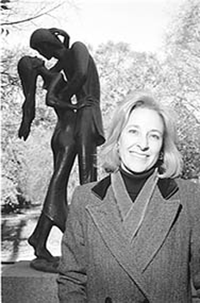
Helen Fisher (Courtesy of Helen Fisher)
CURWOOD: So, an MRI, a scanner. Now this is what, nuclear magnetic resonance? You can see what goes on in someone's head?
FISHER: Yeah. What happens in magnetic resonance imaging is that each brain region sucks up blood as it is working, because it needs the glucose and the oxygen from the blood. And so with this scanner you can see which brain regions are sucking up the blood, which ones are working. And then if you know which region is working – and, in fact, which cells in which region are working, and you know what those cells do for a living, then you can tell what's going on.
What we did is we put – I and my colleagues – put 32 people who were madly in love into this brain scanner. Seventeen who were madly in love and their love was accepted, they were happily in love; and 15 who were, had just been dumped, they had just been rejected in love. But both groups were intensely in love.
CURWOOD: So, you're looking at the images of the brain of these people madly in love. These certain areas are stimulated. What does this mean chemically?
FISHER: I had hypothesized that we would find evidence for elevated activity of the dopamine system and the norepinephrine system. These are natural stimulants in the brain; they give you feelings of elation, giddiness, euphoria, focused attention, motivation, heightened energy, sleeplessness, loss of appetite. These are basic characteristics of romantic love. So I thought we would also find low activity of serotonin because low activity of serotonin is associated with obsessive compulsive behaviors, and certainly the main characteristic of romantic love is you can't stop thinking about this individual. It is an obsession. So that was my hypothesis as I went in.
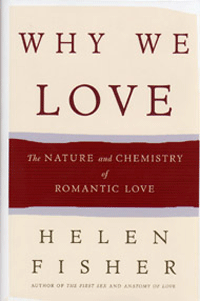
"Why We Love: The Nature of Chemistry and Romantic Love" (Courtesy of Helen Fisher)
CURWOOD: So romance is as important as eating? drinking? breathing?
FISHER: Well, it can be stronger than all of those because some people give up all that in order to win somebody or get out of life when they don't win somebody. Most of us don't though, of course, and eating and drinking is extremely important. I mean, you've got to survive. But, you know what? I mean, I think that romantic love evolved for a very fundamental reason.
CURWOOD: Okay.
FISHER: I think it evolved to enable us to focus our mating energy on just one individual at a time, thereby conserving mating time and energy and starting the most important thing we'll do with our lives, which is forming a pair bond and raising, creating a child. I think the sex drive evolved to get you out there looking for a whole range of partners. I mean, you can have sex with somebody you're not in love with. And I think that attachment, that third brain system, that third drive, evolved to enable us to tolerate this individual, at least long enough to rear a child together.
So I think these three different drives – the sex drive, romantic love, and attachment – all are operating in all kinds of combinations to direct our reproductive lives. And you asked me, is this more important than eating and drinking? Sure. It is.

(Flickr/Capt Kodak)
FISHER: Right.
CURWOOD: What about the sex drive? What are the chemicals there? Are they different from romance chemicals?
FISHER: The main chemical of the sex drive is testosterone, in both men and women. In fact, you know, you inject testosterone in any kind of animal and sex drive goes up. And the brain system is different, too. I mean, there's at least five brain scanning studies of the sex drive, and the various brain regions involved are – they overlap, but they're different from those regions associated with romantic love. So there's two different systems. But they interact, and that's what's so interesting to me.
For example, you know, when you fall in love with somebody, suddenly that person becomes enormously sexually attractive to you. Three weeks ago it was just a nice, another nice person at the office or in your social circle or at the gym. But suddenly everything they do becomes attractive to you. And I think that it is in part because elevated activity of the dopamine circuits associated with romantic love trigger testosterone and trigger the sex drive. So this is why it is that you suddenly become almost, you know, totally fixated sexually on somebody who you're in love with.
What I find most remarkable about these three drives – the sex drive, romantic love, and attachment – is that they're often unconnected. You can feel a powerful sense of attachment to a long-term partner while you feel intense romantic love for somebody else, while you feel this sex drive for a whole range of people. So this is what gets the human animal in so much trouble.
CURWOOD: I bet. Now, let's go back to lust, or the sex drive, and romance. You say that romance can kindle the sex drive. What about the other way around? Can lust lead to romance?
FISHER: Not always, of course. You know, most liberated adults have copulated with somebody who they never fell in love with. In fact, they would have liked to have fallen in love with them and couldn't do it. But it certainly can happen, and it can happen I think in part because with orgasm there's a spike of dopamine – it just shoots up and shoots down again. And that I think can help change the threshold for your ability to fall in love and just turn you over that edge. Also with orgasm you get a real flood in the brain of oxytocin and vasopressin, and these are the chemicals associated with attachment.
So, casual sex isn't always that casual. As a matter of fact I think women are more vulnerable than men are because, as it turns out, seminal fluid has in it all the chemicals in it for the sex drive, the testosterone and estrogen; oxytocin and vasopressin, associated with attachment; and dopamine and norepinephrine, associated with romantic love. So a man is actually doing some chemical finagling when he deposits his sperm. So, you know, casual sex can be casual, but generally it's not.
CURWOOD: Now, you also said that you looked at people who had just been jilted or dumped or crushed.
FISHER: Right.
CURWOOD: What happened in their brains?
FISHER: Well, first of all, Steve, I want to tell you how hard that was to do. You know, I interviewed all these people before I put them in the machine, but people who've just been dumped are in horrible shape. I mean, there were times when I had to go step into a dark room and collect myself and then go back and talk to them. Because some of these were furious, some of them were almost paranoid, some of them were...they were deeply depressed. I mean, romantic rejection is no joke.
And, so, what I did – they did the same experiment. You know, they would look at a photograph of their sweetheart and they would also look at a neutral photograph. We found a lot of things, but among the things that we found is we found activity in a brain region, the insular cortex, where other experiments have shown that this particular region is associated with physical pain in the skin and muscles. Not just psychological pain when you're rejected, but physical pain.
We also found activity in a brain region called the nucleus accumbens. It's a brain region, this particular part of the nucleus accumbens is associated with risking, taking big risks. Actually gambling, gambling for money. Taking big risks for big gains and big losses. And, of course, that's what you do when you've been rejected, you're just willing to do just about anything to win this person back.
And then we also found activity in a brain region near the front of the brain called the lateral orbital frontal cortex. And this brain region, this particular part of the cortex, is associated with three things. Obsessive and compulsive behaviors, and of course you obsessively think about this person. With controlling anger, and that's one thing that happens when you get dumped, you get angry, most people do.
And last but not least, this is a brain region associated with what scientists call a "theory of mind." And what theory of mind is is when people do it, probably much more than other animals, projecting yourself into another person's shoes and thinking, 'What is he thinking about? What is he doing? What is he planning? He's thinking about this or that.' That's theory of mind, and that's what happens when you get rejected. You feel physical pain, you're willing to take huge risks, you're constantly wondering what this other person is thinking, you're obsessively thinking about them and you're trying to control your anger.
CURWOOD: What is the secret of making love last? I mean, can you tell us what you've found about this?
FISHER: I want to say, first of all, that there's very nice data that in long-term attachments you can make love last. That, indeed, if it's a very good relationship there often is a continual thread of romantic love in the relationship as well as deep attachment to the person. You'll feel the romantic love when you're on a vacation, when suddenly you go out on a date with your husband or wife, when something fun happens, when he cracks a joke, when he's wearing a beautiful suit, etc., etc. It can come back.
But, anyway, one of the ways to sustain romantic love in a long-term marriage is to do novel, exciting, slightly dangerous things together. Because novelty drives up the activity of dopamine in the brain. This is why vacations can be so exciting. Just doing something new.
CURWOOD: Helen Fisher's book is called "Why We Love: The Nature and Chemistry of Romantic Love." Thank you so much, Helen Fisher.
FISHER: Thank you.
GELLERMAN: Our interview was conducted by Living on Earth’s Steve Curwood.
Related links:
- Helen Fisher's website
- “So what, really, is this thing called love” by Lauren Slater, Feb. 2006 National Geographic
GELLERMAN: On the next Living on Earth, living forever—it just might be possible.
KURTZWEIL: According to my models we will be adding more than a year, every year, to your remaining life expectancy in about 15 years. So as you go forward a year, your life expectancy will move on away from you.
GELLERMAN: Leaps and bounds for life-spans—thanks to scientists and nanobots! Next time on Living on Earth.
|
|
GELLERMAN: We leave you this week with a bit of snap, crackle and pop! The Canada Glacier is a small ice mass in Antarctica’s Taylor Valley. As the weather warms, the glacier melts and produces streams that feed lakes to the East and West.
By the way, since this glacier only gets about four inches of snowfall every year, it’s considered a cold desert. Doug Quin recorded these clicks and clacks for the wildsanctuary.com CD “Antarctica.”
[Doug Quin, “Antarctica”, www.wildsanctuary.com]
Living on Earth is produced by the World Media Foundation. Our crew includes Ashley Ahearn, Bobby Bascomb, Eileen Bolinsky, Ingrid Lobet, Helen Palmer, Emily Taylor, and Jeff Young, with help from Jennifer Baessler, Sarah Calkins and Mitra Taj. Our interns are Annie Jia and Margaret Rossano.
Jeff Turton is our technical director. Alison Lirish Dean composed our themes. Steve Curwood is our executive producer.
You can find us at L-O-E dot org. I’m Bruce Gellerman. Thanks for listening.
ANNOUNCER: Funding for Living on Earth comes from the National Science Foundation, supporting coverage of emerging science, and Stonyfield Farm Organic yogurt and smoothies. Stonyfield pays its farmers not to use artificial growth hormones on their cows. Details at Stonyfield.com.
Support also comes from you our listeners, the Ford Foundation, the Town Creek Foundation, the Oak Foundation supporting coverage of climate change and marine issues. And Pax World mutual funds, socially and environmentally sustainable investing. Pax World, for tomorrow. On the web at paxworld.com.
ANNOUNCER: PRI: Public Radio International.
Living on Earth wants to hear from you!
Living on Earth
62 Calef Highway, Suite 212
Lee, NH 03861
Telephone: 617-287-4121
E-mail: comments@loe.org
Newsletter [Click here]
Donate to Living on Earth!
Living on Earth is an independent media program and relies entirely on contributions from listeners and institutions supporting public service. Please donate now to preserve an independent environmental voice.
NewsletterLiving on Earth offers a weekly delivery of the show's rundown to your mailbox. Sign up for our newsletter today!
 Sailors For The Sea: Be the change you want to sea.
Sailors For The Sea: Be the change you want to sea.
 The Grantham Foundation for the Protection of the Environment: Committed to protecting and improving the health of the global environment.
The Grantham Foundation for the Protection of the Environment: Committed to protecting and improving the health of the global environment.
 Contribute to Living on Earth and receive, as our gift to you, an archival print of one of Mark Seth Lender's extraordinary wildlife photographs. Follow the link to see Mark's current collection of photographs.
Contribute to Living on Earth and receive, as our gift to you, an archival print of one of Mark Seth Lender's extraordinary wildlife photographs. Follow the link to see Mark's current collection of photographs.
 Buy a signed copy of Mark Seth Lender's book Smeagull the Seagull & support Living on Earth
Buy a signed copy of Mark Seth Lender's book Smeagull the Seagull & support Living on Earth


